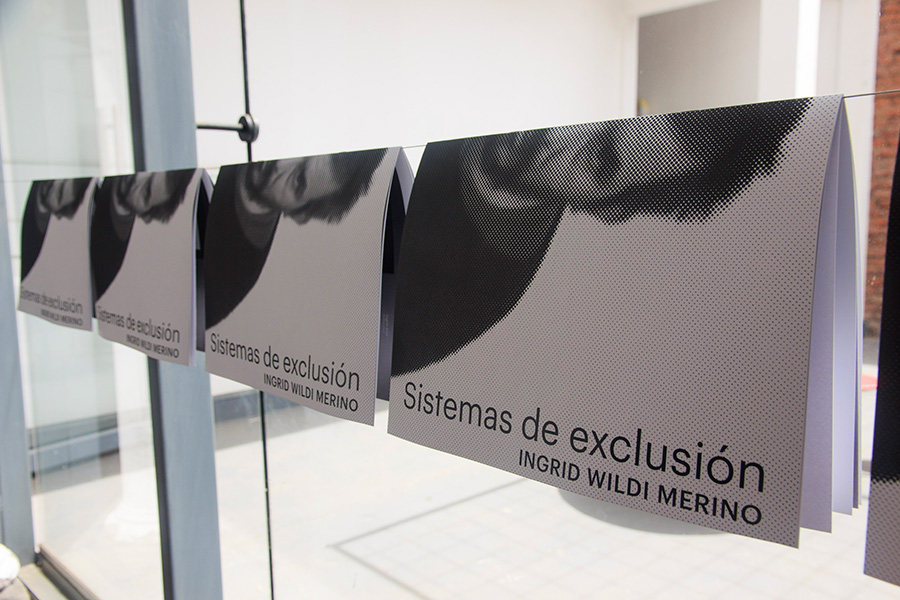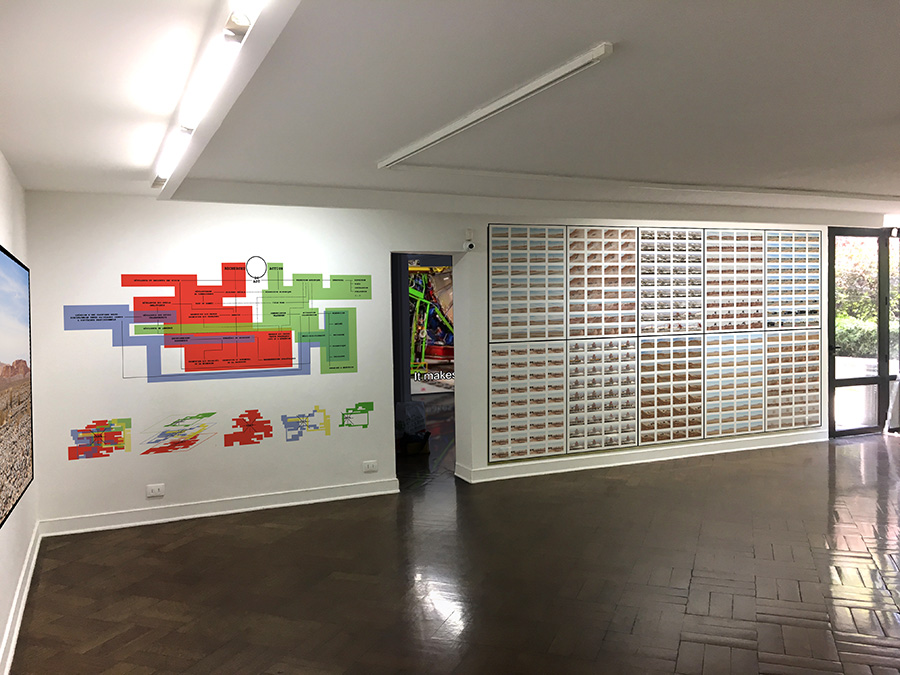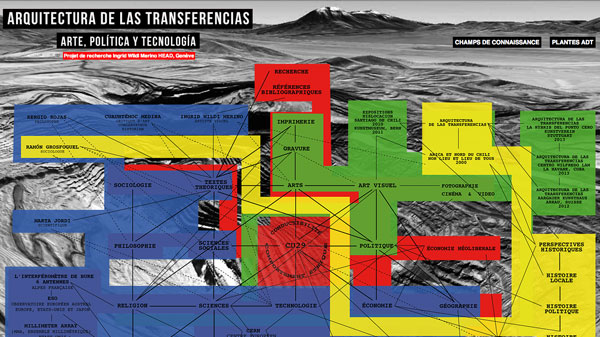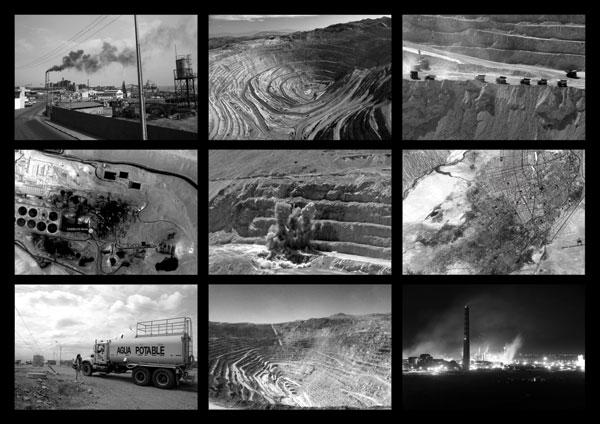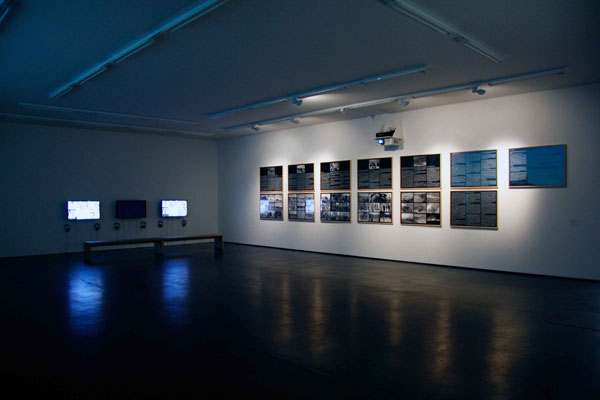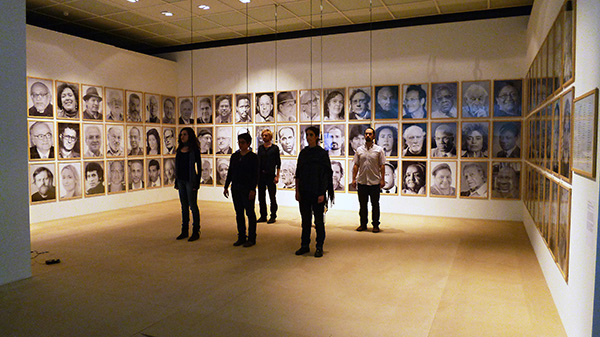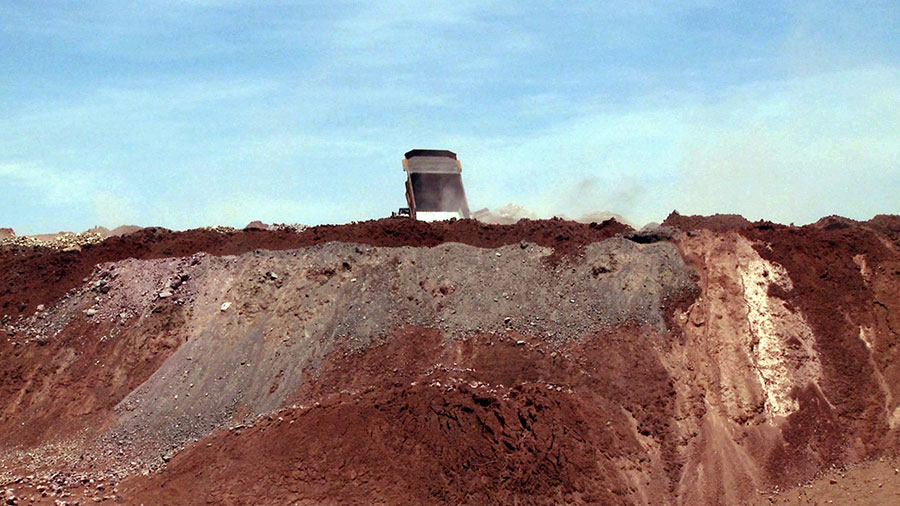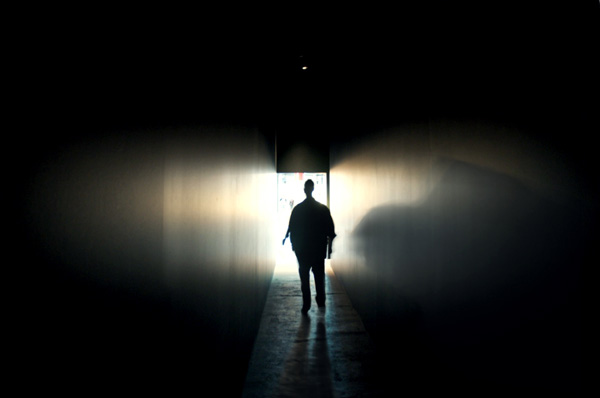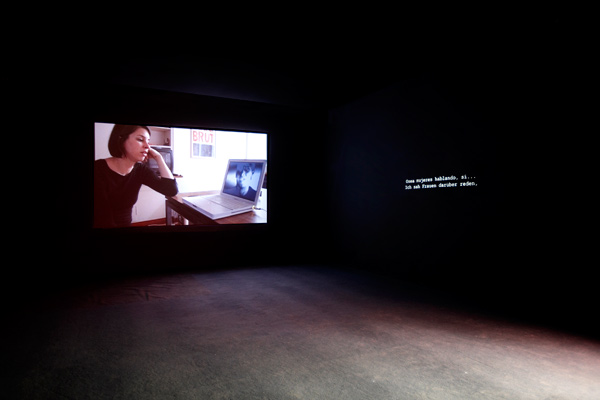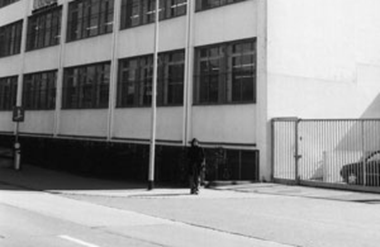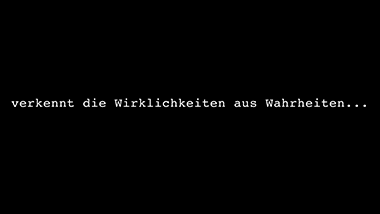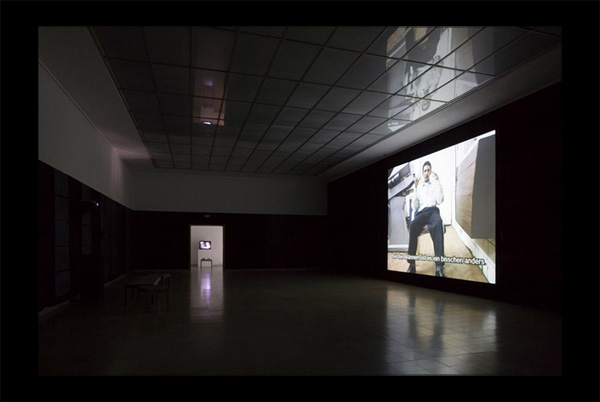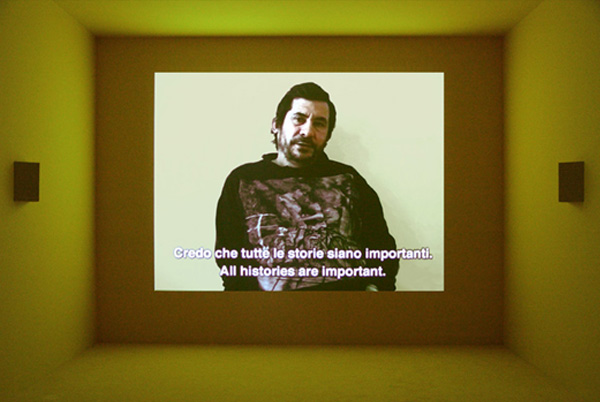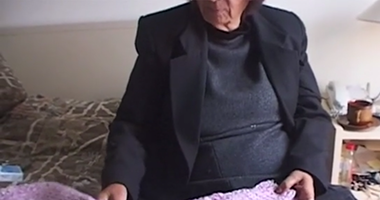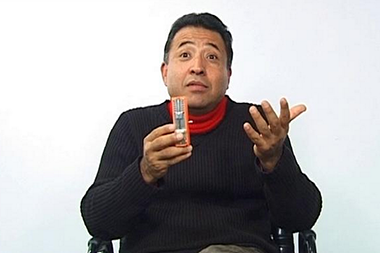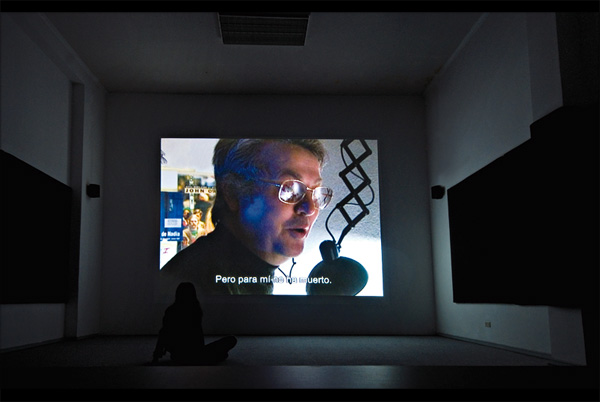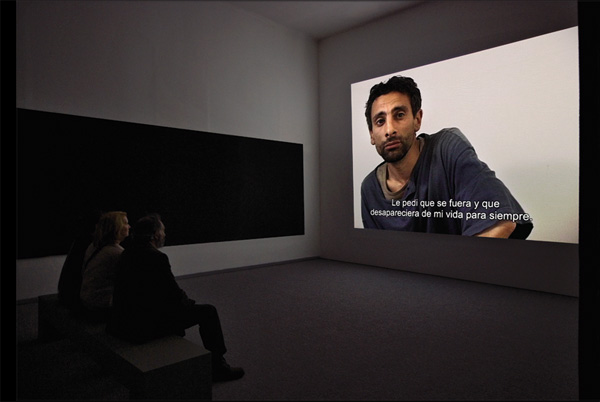Los Invisibles
Projection video (BETA DIGITAL/DVD) 35:00 min. Language: spanish, Subtitle: English. 2007.
Five Colombian immigrants living clandestinely in Switzerland for many years evoke their situation, their suffering, their fears and the reasons that led them to leave their country. By discontinuous montage and the fragmentation of her interlocutor’s accounts, artist Ingrid Wildi builds up an arborescent address about the inherent problematic of clandestinity status - identity conflict, cultural and linguistic bond issues, social integration’s difficulties.
In order to preserve their anonymity, only body fragments – torso and arms - of the interviewed persons are shown on screen, that device calling to mind simultaneously the missing part of the filmed subjects and their situation of « invisibility ».
Ingrid Wildi’s latest video essay paradoxically shows us the unseen, by putting into the spotlight few of the many "invisible" co-citizens who surround us. Through her interviews, we are not only given the opportunity to see them, but also, and especially, to listen to them. While the facelessness of these clandestine witnesses underscores the difficulty of granting them a social identity, this same facelessness gives their migrant bodies a voice they are usually deprived of.
These voices refer to the very specific and current context of illegal Colombian workers in Switzerland. But this example is emblematic of a situation shared today by many other displaced persons, since, in our globalized world, the invisibility, intrinsic to the ineffable status of illegal workers, has become one of the most widespread side effects of economic growth.
Beyond the social distress they evoke, these testimonies weave also a polyphonic tale on the painful memory of exile. These invisible people, both actors and victims of the economic flows supposed to guarantee a common welfare, tell us here a story about the pursuit of happiness quite different from the one we tend to fantasize about, or the one we are told about by those governing us.
Pedro Jiménez Morrás
September 2007
Los invisibles (The Invisible Ones)
Este video trata las problemáticas de los inmigrantes ilegales en Ginebra. Los protagonistas vienen exclusivamente de Colombia, y están permanentemente absorbidos por el sufrimiento de ser deportados y retornados a su lugar de
origen.
El ensayo video “Los invisibles” propone una mirada sobre la problemática de los inmigrantes ilegales que residente en el territorio suizo desde hace varios años. Las personas que participan en este proyecto son todos originarios de Colombia y residen en Ginebra. La gran mayoría de ellos viven sin papeles desde hace años, absorbidos por el sufrimiento y el miedo de que llegue el día en que serán “deportados” (expresión que emplean ellos mismos para designar el acto de devolución a sus países).
Develando ciertos aspectos de las problemáticas inherentes al estatuto de clandestinidad, me propongo proporcionar visibilidad a una realidad marcada por la disimulación. Intento mostrar, de algún modo, una faceta de estos recorridos realizados al margen, en un estado de ilegalidad que genera sus propios conflictos y sus propias limitaciones –precariedad total de empleo, conflictos de identidad y cuestiones de pertenencia, cultural y lingüística. Abordo, por esta misma vía, la noción de invisibilidad. ¿Cómo dar visibilidad a individuos que por razones de seguridad o de estabilidad, son obligados al anonimato, a la absoluta discreción, a la invisibilidad social?, ¿De qué modo puede ser relatada esta invisibilidad que induce un sentimiento de inexistencia para aquellos que la experimentan? Filmar es un acto que atestigua lo visible y que compone una manera de hacer visible lo que está disimulado.
![]()
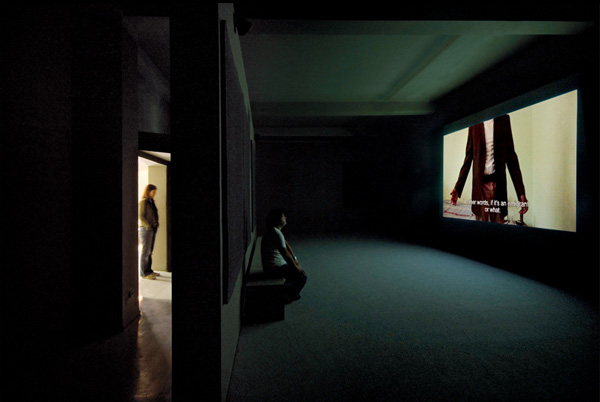
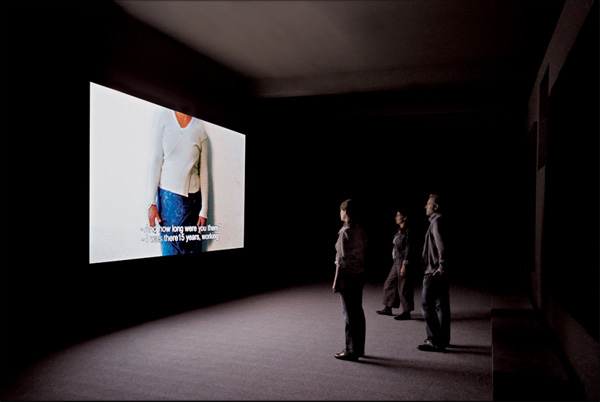
Cut (s)
« Can you spot an immigrant in the street ? », asks artist Ingrid Wildi to one of her interlocutors. And as he briefly answers the question, facing the camera, the quiver that we perceive in his voice is only visible through the movement of his hands folding up with a light and faint convulsion. The issue of acknowledgement in Los invisibles, is treated by its denial : the artist deletes what could allow the identification – in the literal meaning – of the interviewed persons (their faces). Hence, the video-essay Los invisibles pursues a process already initiated in other works : invisibility is already central in Si c’est elle (2000), where four men successively evoke a woman that they loved. And the works Quelquepart I (2001) and Quelquepart II (2006) are both built around the projectionist’s face who must remain unseen , invisible to the spectator’s eye, so that the cinematography be carried out. However, Los invisibles uses strict rigour and means that are already existent in former works (non-linear montage, fragmentation of speech, elliptic and fragmented narrative layout), it also reaches a limit to what the act of filming offers in its ability of realness restitution : how do we bestow visibility to those who, by necessity or by constraint, are enclosed by an invisibility status ? How do we shoot what must not be seen ?
When Ingrid Wildi works from the non-visible, it is probably to reveal, through shortage, what cannot be said by sole presence. Like the way the artist gives great significance to silence in the speech fragments that she brings together, the missing portion of these cut and unrecognisable bodies suggests what can’t be shown, yet what integrates the scope and the completeness of the video-essay. The cut calls for the loss and what the spectator’s eye is looking for, in this cruel sharing of the visibleness ; this is precisely the piece that seems to have been lost in the way.
In Los invisibles, the fragmentation of the body through framing answers to the speech parcelling out, set up by the montage. The work of artist Ingrid Wildi proceeds through the dialectics of cutting and assembling. One body takes the place of another, one speech interrupts or carries on another speech. The story’s narrative thread is built up by omission, by ellipsis : the same way these bodies are broken, the stories told by the people interviewed are fragmented so as to be remodelled, rewritten. And where the frame is inevitably steady, the motion occurs by the montage’s splicing, the rhythm of the cuts, the linking of the filmed bits. In Los invisibles, the cut works out as a definite means, but it also interplays with the living situation of these « invisible » immigrants.
The cut is what separates : that’s the border, the distance between « here » and « over there », the gap between recognition and anonymity, visibility and invisibility ; that’s the brutal difference between desire and reality (« does love have something to do with economics ? », asks Wildi to one of the characters). The cut is also what establishes the lack, the wound : how do we find the face that only belongs off screen back ? How do we regain an identity that seems torn apart ? Somehow, Los invisibles intervenes as a prosopopeia, a figure through which we make the absent one speak : interlocutors without a face, anonymous enunciators, the clandestine immigrants interviewed by Ingrid Wildi evoke their own absence, they set their own non-fulfilment and the one of those who share the same fate ; they speak for those who are not there, those whom we don’t see, that we don’t hear. And when Ingrid Wildi’s work restores a piece of visibility to these hidden faces for a moment, it also tells on, by an almost imperceptible manner, the fact that these immigrants are not so destined to an acknowledgement in the near future than a much more asserted process of evanescence : as an answer to the slow fading of the day’s light, the artist’s interlocutors are, as the story goes on, progressively exposed to a growing obscurity. « Can you spot an immigrant in the street ? » - « Yes », answers the man in the brown suit at once, as the light around him so much faded, that soon it will be him that will become another shadow among the room’s furniture, as fainted and once more « invisible ».
